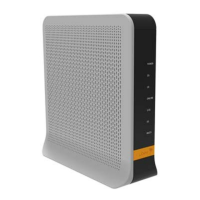Ubee Interactive Using the Options Option
Ubee DDW36C Advanced Wireless Gateway MSO Operations Guide • October 2015 49
Primary Network Bridged When enabled, this allows bridging of traffic to and from the
Internet for ALL LAN side primary interfaces (Ethernet, MoCA,
and Wireless Primary Network).
Note: When the Primary Network Bridged option is enabled,
menu items for other functions can still be seen, but are not
active.
DNS Relay Allows the DDW36C to act as the “relay” device. Each PC that
wants to access a URL does not have to send a DNS request
to a DNS server on the Internet. DNS is used to resolve a URL
(Web site name) to an IP address. DNS Relay is typically used
for commercial applications where each device/PC connected
to the device uses the DNS Relay address rather than going to
a public DNS server hosted by an ISP to look up a URL.
NAT ALG Status – Filters to allow (enable) or disallow (disable) protocols to pass through the
DDW36C to connected devices (computers, game consoles, and so on).
RSVP Enables or disables resource reservation protocol (RSVP).
RSVP defines how applications reserve resources and how
they free the reserved resources once they are no longer
needed.
FTP Enables or disables the file transfer protocol (FTP) used to
transfer files from one host to another.
TFTP Enables or disables the trivial file transfer protocol (TFTP) – a
simpler protocol generally used for automated file transfers.
Kerb88 Enables or disables the Kerberos network authentication
protocol which allow nodes to communicate over a non-secure
network using “tickets” on port 88 to prove their identity to one
another.
NetBios Enables or disables the network basic input/output system
(NetBIOS) services related to the OSI session layer. NetBIOS
allows applications on separate computers to communicate
over a LAN.
IKE Enables or disables the network key exchange (IKE) protocol
used to set up a security association (SA) in the IPsec protocol
suite.
RTSP Enables or disables the real time streaming protocol (RTSP)
network control protocol used to establish and control media
sessions between end points.
Kerb1293 Enables or disables the Kerberos network authentication
protocol which allows nodes to communicate over a non-
secure network using “tickets” on port 1293.
H225 Enables or disables the H.225 protocol used to define
messages and procedures for call signaling, media
packetization, and registration, admission, and status (RAS)
functions.
PPTP Enables or disables the point-to-point tunneling protocol
(PPTP) used to implement a virtual private network.
Label Description

